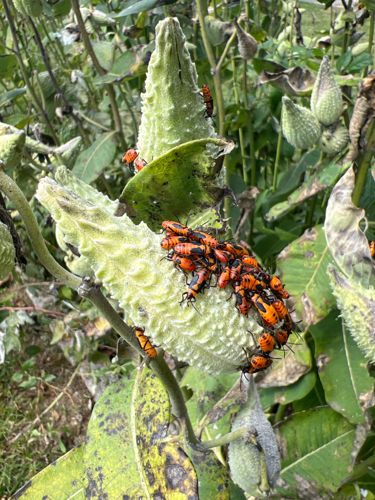Large Milkweed Bug
Scientific Name: Oncopeltus fasciatus
Order & Family: Hemiptera (True Bugs), Family: Lygaeidae (Seed Bugs)
Size: Adults typically range from 10 to 18 mm (0.4 to 0.7 inches) in length.

Natural Habitat
Commonly found in fields, meadows, gardens, and along roadsides where their host plants, milkweeds (Asclepias spp.), grow. They are especially prevalent on milkweed plants.
Diet & Feeding
Primarily feed on the seeds of milkweed plants, using their piercing-sucking mouthparts to extract fluids. They will also feed on various parts of the milkweed plant, including leaves and stems, but prefer the seeds. They are specialists.
Behavior Patterns
They are often found in large aggregations, particularly nymphs, as seen in the image. This clustering behavior is thought to offer protection from predators. Their bright orange and black coloration is a form of aposematism, warning predators of their toxicity, which they acquire from ingesting cardiac glycosides from milkweed plants (the same toxins that benefit Monarch butterflies). They undergo incomplete metamorphosis, with nymphs resembling smaller, wingless versions of the adults.
Risks & Benefits
Generally considered harmless to humans and are not pests of agricultural crops. While they feed on milkweed, they typically do not cause significant damage to the plant population. They serve as a food source for some predators that can tolerate their toxicity. Their presence on milkweed is often an indicator of a healthy milkweed patch, which is crucial for Monarch butterfly conservation as milkweed is the sole host plant for Monarch caterpillars. However, very large populations might compete with Monarchs for resources on individual plants to some extent, but this is usually not a major concern.
Identified on: 9/9/2025